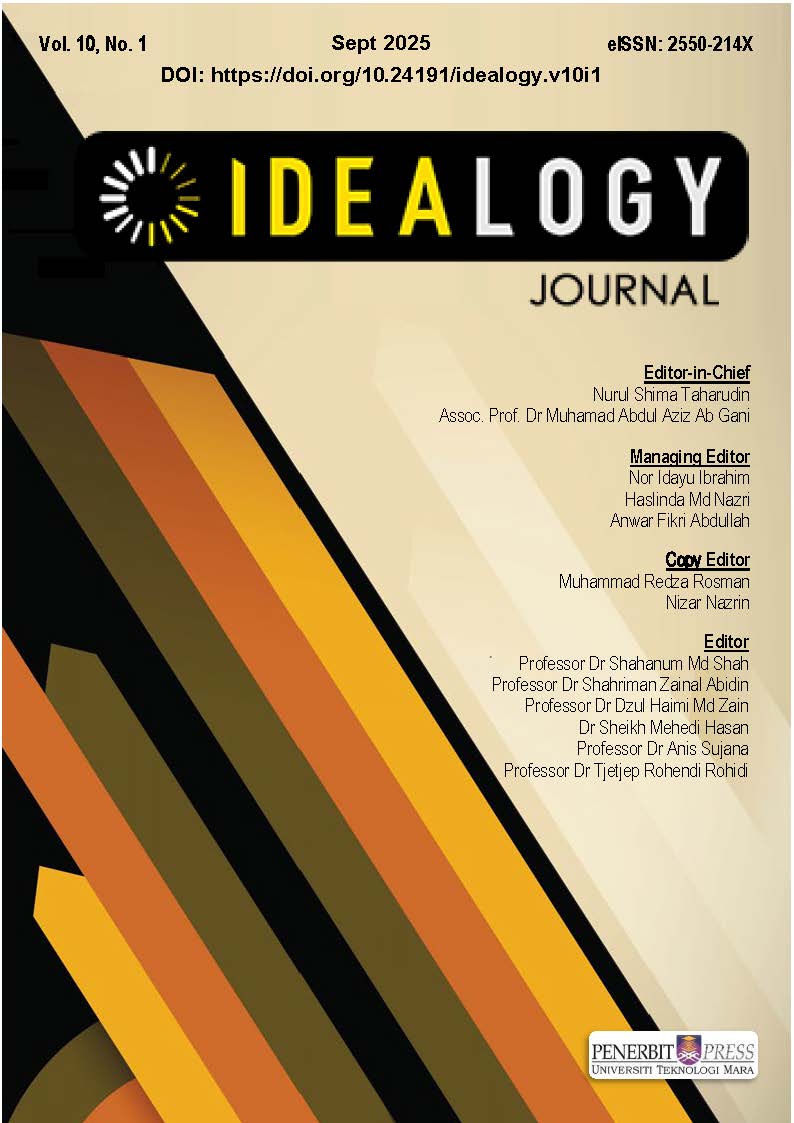Tradition Meets Innovation: Malay Symbols (Tanggam) In Contemporary Sculpture - An Analysis of Hilal Mazlan's Kinetic Sculpture (Labyrinth)
DOI:
https://doi.org/10.24191/idealogy.v10i1.705Keywords:
Tanggam, Kinetic Sculpture, Malay Symbols, Hilal Mazlan, Modern Art TechniquesAbstract
This research explores the intersection of tradition and innovation in contemporary sculpture, focusing on the selected sculpture of Hilal Mazlan. Through an in-depth analysis of Hilal's kinetic sculpture, the research examines how traditional Malay symbols, particularly the concept of 'Tanggam,' are reinterpreted and integrated into modern art forms. Tanggam, a traditional woodworking technique known for its intricate joinery and cultural significance, serves as a foundational element in Hilal's artistic expression. By incorporating kinetic elements, Hilal revitalizes these cultural motifs, creating dynamic sculptures that engage viewers on both an aesthetic and conceptual level. This analysis highlights the ways in which Hilal's work navigates the dialogue between heritage and modernity, offering new insights into the evolving landscape of contemporary Malaysian art. The researcher used a qualitative research method in this research. This kind of method uses combining techniques between primary and secondary data. Edwin Panofsky's theory will be used as a means to conclude this research and to analyse Hilal “Labyrinth” sculpture.
Keywords: Tanggam, Kinetic Sculpture, Malay Symbols, Hilal Mazlan, Modern Art Techniques
References
Abdul Halim Nasir, 1985. Pengenalan Rumah Tradisional Melayu
Abdul Halim Nasir, 1986. Ukiran Kayu Melayu Tradisi.
Abdul Halim Nasir, 1997. Seni Bina Masjid dan Rumah Melayu
Abdul Rahman Al-Ahmadi, 2016. Petua Membina Rumah Melayu dari Sudut Antropologis
Ahmad, S. (2018). Tradition in Transition: Tanggam and Malay Symbolism in Contemporary Art. Journal of Southeast Asian Art, 34(2), 175–188.
Ali, M. (2020). Nature and Philosophy in Malay Art: Reflections in Contemporary Practices. Asian Art Journal, 15(4), 223–240.
Chin, E. (2020). Reimagining the Past: Heritage and Identity in Contemporary Art. Culture & Critique, 12(1), 45–63.
Clifford, J. (1997). Routes: Travel and Translation in the Late Twentieth Century. Harvard University Press.
Elgammal, A., Liu, B., Elhoseiny, M., & Mazzone, M. (2017). CAN: Creative Adversarial Networks, Generating "Art" by Learning About Styles and Deviating from Style Norms.
Harrison, R. (2015). Heritage: Critical Approaches. Routledge.
Hussain, A. (2012). Modern Malaysian Art: From the Fifties to the Eighties. Dewan Bahasa dan Pustaka.
Ismail, W. M. (2005). The Malay Woodworking Tradition. Dewan Bahasa dan Pustaka.Jamal, S. A. (2007). Pioneers of Malaysian Art. RogueArt.Kosuth, J. (1991). Art After Philosophy and After: Collected Writings, 1966-1990. MIT Press.
Krauss, R. (1977). Passages in Modern Sculpture. MIT Press.
Mazlan, H. (2023). Tradition and Modernity in Malay Art: A Research of Kinetic Sculpture. Journal of Contemporary Art and Culture, 15(2), 45-62.
Mubin Sheppard, D. (1983). Taman Indera: A Royal Pleasure Ground. Oxford University Press.
Nasir, A. H., & Wan Teh, W. (1996). The Traditional Malay House. Institut Terjemahan Negara Malaysia.
Nora, P. (1989). Between Memory and History: Les Lieux de Mémoire. Representations, 26, 7–24.
Osman, Z. (2014). Malaysian Contemporary Art: Shaping a National Identity. National Art Gallery Malaysia.
Panofsky, E. (1939). Studies in Iconology: Humanistic Themes in the Art of the Renaissance. Oxford University Press.
Rahim, D. (2019). Cultural Identity and Innovation in Malaysian Sculpture: The Works of Hilal Mazlan. Art and Identity Studies, 10(3), 52–69.
Rahim, D. (2019). Tradition and Innovation in Malaysian Sculpture: A Contemporary Perspective. Perak: UiTM Publications.
Rahman, N. (2022). The Art of Tanggam: Traditional Malay Woodworking Techniques. Malaysian Journal of Arts and Crafts, 11(4), 78-89.
Rosenberg, H. (1972). The De-definition of Art: Action Art to Pop to Earthworks. University of Chicago Press.
Smith, T. (2016). Contemporary Art and Cultural Identity: Exploring Heritage in Modern Artistic Practices. Art History Journal, 45(3), 321–340.
Wong, T. (2021). The Evolution of Kinetic Sculpture in Southeast Asian Art. Asian Art Review, 12(3), 102-115.
Zulkifli Yusoff. (2005). The Dynamics of Malaysian Sculpture: Tradition and Modernity. Journal of Southeast Asian Studies, 36(2), 321-340.
Downloads
Published
Issue
Section
License
Copyright (c) 2025 Idealogy Journal

This work is licensed under a Creative Commons Attribution-NonCommercial-NoDerivatives 4.0 International License.
UiTM Press (the Publisher) has agreed to publish the undersigned author’s paper in Idealogy Journal. The agreement is contingent upon the fulfilment of a number of requirements listed below.
1. The undersigned author warrants that the paper entitled below is original, that it is not in any way libellous or unlawful in Malaysia, that it does not infringe any copyright or other proprietary right. The undersigned hereby represents and warrants that he/she is the author of the paper, except for material that is clearly identified as to its original source, with permission notices from the copyright owners where required. The undersigned represents that he/she has the power and authority to sign and execute this agreement.
2. The undersigned author warrants that the paper entitled below has not been published elsewhere, and also it will not be submitted anywhere else for publication prior to acceptance/rejection by this Journal.
3. By submitting the paper entitled below, the undersigned author agrees to transfer the rights to publish and distribute the paper in an international e-journal (entitled above) to Publisher.
4. The undersigned author agrees to make a reasonable effort to conform to Publisher's submission guidelines and to liaise with the editor to ensure that the requirements of these guidelines are met to a reasonable degree.
5. The corresponding author signs for and accepts responsibility for releasing this material on behalf of any and all coauthors. This agreement is to be signed by at least one of the authors who has obtained the assent of the co-author(s) where applicable. After submission of this agreement signed by the corresponding author, changes of authorship or in the order of the authors listed will not be accepted.


